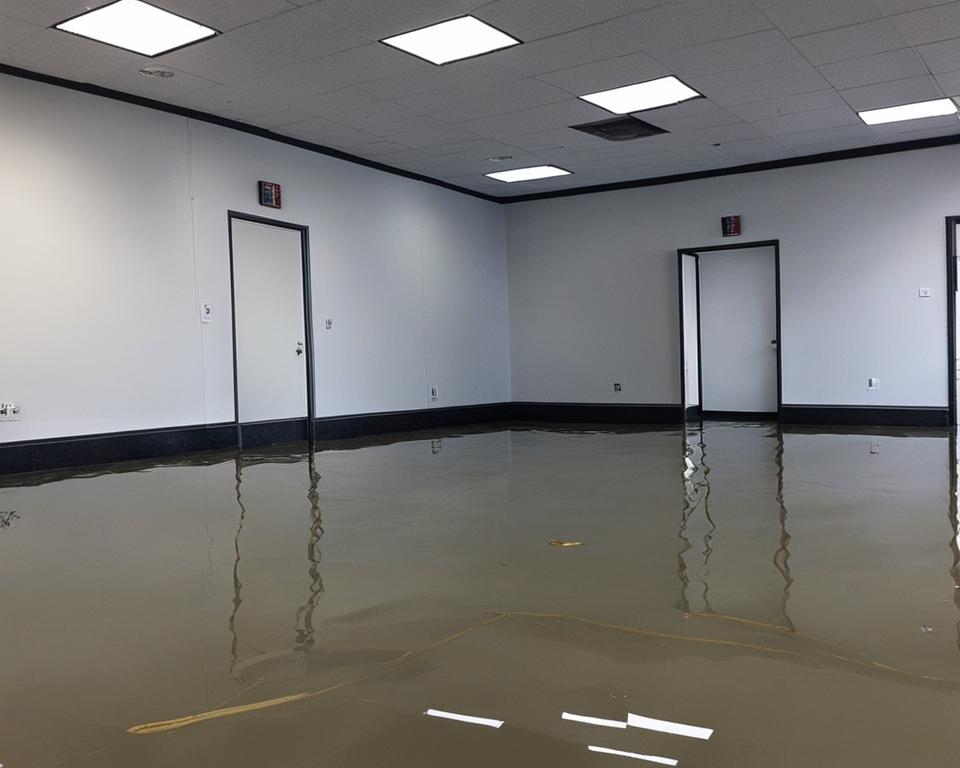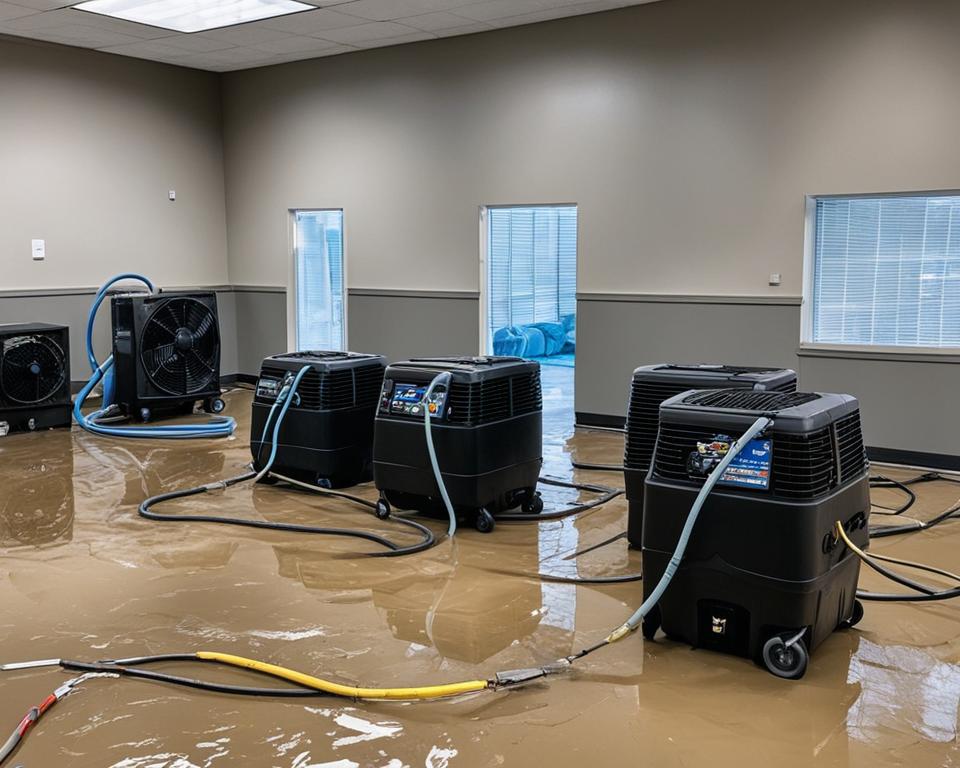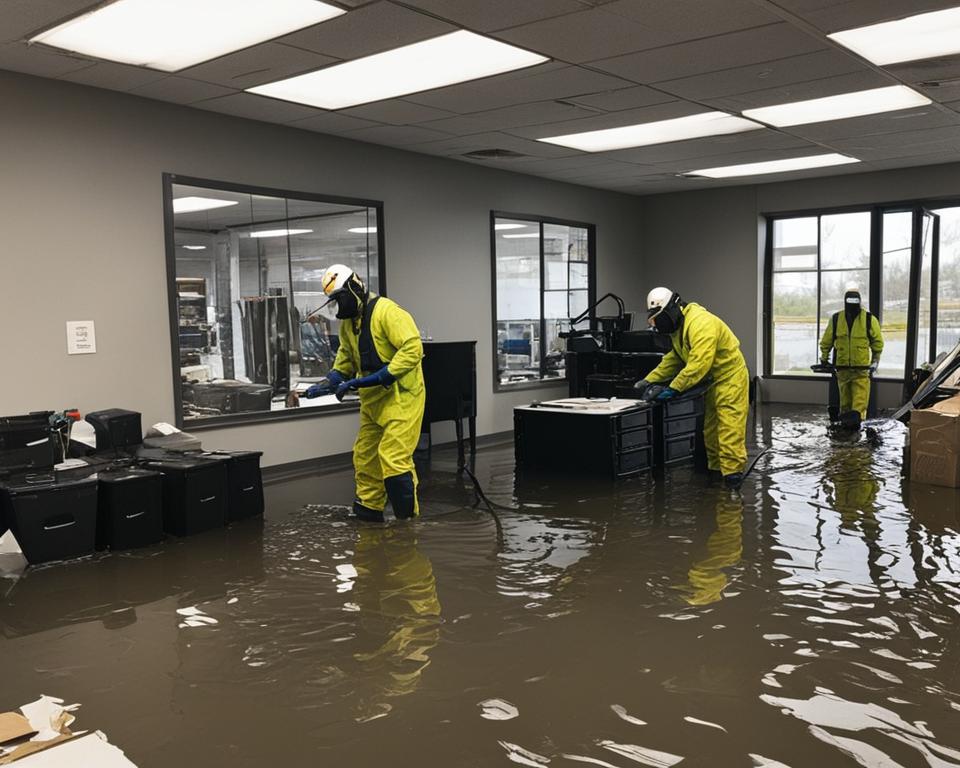Water damage can be devastating for commercial properties, posing a significant threat to business continuity and property value. To ensure a swift and effective recovery, it is crucial to seek professional water damage restoration services. In Chicago, one of the leading experts in this field specializes in helping business and property owners overcome the challenges posed by water damage in commercial properties.
When faced with water damage, immediate action is essential to prevent further harm and the growth of mold. Contacting a professional restoration company is paramount in addressing water damage effectively. The restoration process typically includes a thorough assessment, water mitigation, cleanup, drying out, sanitization, and restoration. By taking swift and comprehensive action, property owners can minimize damage and restore their commercial spaces to their pre-loss condition.
To prevent the growth of mold, it is vital to emphasize the importance of prompt action and thorough drying. Mold can thrive in moist environments, leading to additional health risks and further damage to the property. Therefore, ensuring the premises are adequately dried is a critical step in the restoration process.
It is crucial for business owners to have comprehensive commercial property insurance coverage. This will help alleviate the financial burden associated with water damage restoration and ensure a smoother recovery process. By understanding the extent of their coverage and potential reimbursement, property owners can make informed decisions and avoid high restoration costs.
Responsibility for water damage in commercial leased properties can vary based on the lease agreement. It is important to review the terms and conditions outlined in the lease to determine who bears the responsibility for water damage restoration. Regular inspections and preventive measures can help minimize the risk of future water damage incidents, safeguarding the commercial property and mitigating potential disputes between landlords and tenants.
Key Takeaways:
- Hiring professional water damage restoration services is crucial for effective and efficient recovery.
- Prompt action is essential to prevent further damage and the growth of mold.
- Comprehensive commercial property insurance coverage is necessary to avoid high restoration costs.
- Responsibility for water damage in commercial leased properties depends on the lease agreement.
- Regular inspections and preventive measures can help avoid future water damage incidents.
Signs and Causes of Water Damage in Commercial Properties
Water damage in commercial properties can be a costly problem that needs immediate attention. Recognizing the signs and understanding the causes of water damage is crucial for effective commercial property water damage restoration and repair.
Signs of Water Damage
There are several signs that indicate water damage in commercial properties:
- Damaged windows: Cracked or broken windows can allow water to seep into the property.
- Leaking pipes: Dripping or leaking pipes can cause water damage, leading to mold growth and structural issues.
- Roof leaks: Roof leaks can result in water infiltrating the building, damaging ceilings, walls, and valuable assets.
- Sewer clogs: Sewer backups can cause extensive water damage and pose health risks.
When any of these signs are detected, it is important to take immediate action to prevent further damage and seek professional commercial water damage repair services.
Causes of Water Damage
Water damage in commercial properties can be caused by various factors:
- Improperly sealed windows: Poorly sealed windows can allow rainwater to enter the building, leading to water damage.
- Pipe leaks: Aging or damaged pipes can develop leaks, resulting in water intrusion and potential flooding.
- Roof leaks: Damaged or poorly maintained roofs can allow rainwater to penetrate the building, causing extensive water damage.
- Sewer backups: Clogged or damaged sewer lines can cause sewage to back up into the property, causing significant water damage and health hazards.
Understanding the causes of water damage can help property owners and managers take preventive measures and address issues promptly.
Preventive Measures
To avoid water damage and reduce the need for commercial property flood damage restoration, implementing preventive measures is essential. Some recommended measures include:
- Regular maintenance checks and inspections: Regularly inspecting the property for signs of water damage, leaks, and other issues can help identify and address potential problems early.
- Installing water detection systems: Utilizing water detection systems can alert property owners to leaks or water intrusion, allowing for immediate action.
By being proactive and taking preventive measures, commercial property owners can minimize the risk of water damage and costly restoration services.
| Signs of Water Damage | Causes of Water Damage | Preventive Measures |
|---|---|---|
| Damaged windows | Improperly sealed windows | Regular maintenance checks and inspections |
| Leaking pipes | Pipe leaks | Installing water detection systems |
| Roof leaks | Poorly maintained roofs | |
| Sewer clogs | Sewer backups |
Water Damage Restoration Process in Commercial Properties
In the unfortunate event of water damage in a commercial property, it is crucial to initiate the restoration process promptly to minimize further damage and ensure the timely recovery of your business. The commercial water damage restoration process involves a series of steps that aim to assess the severity of the damage, mitigate the water source, clean up the affected areas, dry out the space, sanitize, and restore the property to its pre-damage condition.
Assessment and Inspection
The first step in the water damage restoration process is to assess the extent of the damage and conduct a thorough inspection of the affected areas. Trained professionals will evaluate the affected spaces to determine the severity of the water damage and develop a restoration plan accordingly. This assessment helps in identifying the areas that require immediate attention and prioritizing the restoration tasks.
Water Mitigation
Once the assessment is complete, the next step is to address the water source and mitigate further damage. This involves identifying and stopping the water source, such as a burst pipe or a leaking roof, to prevent additional water from entering the property. Swift action is necessary to minimize the risk of further structural damage and potential mold growth.
Cleanup and Sanitization
After mitigating the water source, the cleanup process begins. Standing water is removed using specialized equipment and techniques to ensure thorough extraction. The affected areas are then cleaned and sanitized to eliminate any potential health hazards and prevent the growth of harmful bacteria or mold. Commercial-grade cleaning products and disinfectants are used to ensure the safety and well-being of occupants.
Drying Out
Once the cleaning and sanitization process is complete, the affected areas must be thoroughly dried out to prevent further damage. Industrial fans and dehumidifiers are used to expedite the drying process, ensuring that moisture is entirely removed from the structure and materials. This step is crucial to prevent mold growth, which thrives in damp and humid environments.
Restoration
After the affected areas are completely dry, the restoration process begins. This involves repairing and replacing damaged building materials, such as drywall, flooring, and insulation, to restore the property to its pre-damage condition. Restoration professionals ensure that the reconstruction is done using industry best practices and high-quality materials, bringing the commercial property back to its normal operations.
By following a systematic and comprehensive water damage restoration process, commercial property owners can minimize downtime, mitigate further damage, and restore their businesses promptly. It is important to hire a professional water damage restoration company with experience in dealing with commercial properties to ensure efficient and effective restoration.
| Key Steps | Description |
|---|---|
| Assessment and Inspection | Evaluate the extent of water damage and develop a restoration plan. |
| Water Mitigation | Identify and stop the water source to prevent further damage. |
| Cleanup and Sanitization | Remove standing water, clean, and sanitize the affected areas. |
| Drying Out | Thoroughly dry the property to prevent mold growth. |
| Restoration | Repair and replace damaged building materials, restoring the property. |
Preventing Mold Growth After Water Damage in Commercial Properties
Mold growth can pose serious health risks and further damage to commercial properties after water damage occurs. Taking immediate and effective action is crucial to prevent mold from spreading and causing additional problems. Here are essential steps to follow:
- Turn off water sources: As soon as the water damage is detected, it is important to stop the flow of water by shutting off the main water supply or addressing the source of the leak.
- Remove standing water: Use commercial-grade pumps or wet/dry vacuums to thoroughly remove any standing water from the affected areas. This helps prevent further water infiltration and limits the potential for mold growth.
- Dry the area: Properly drying out the affected spaces is crucial in preventing mold growth. Utilize dehumidifiers, fans, and other drying equipment to expedite the drying process.
- Sanitize the affected spaces: Thoroughly clean and sanitize the areas that have been exposed to water to eliminate any existing mold spores and inhibit further bacterial growth.
- Apply antimicrobial treatments: Consider utilizing antimicrobial treatments to prevent mold and bacterial growth. These treatments can provide an extra layer of protection against future mold-related issues.
Remember, comprehensive commercial property insurance coverage is essential to mitigate the high costs associated with water damage restoration. It is critical to have proper insurance to safeguard your commercial property in the event of unforeseen water damage incidents.

Mold Prevention Tips:
- Conduct regular inspections to identify and address any potential water damage issues promptly.
- Maintain proper ventilation in areas prone to excess moisture, such as bathrooms and basements.
- Address leaks, plumbing issues, and roof problems immediately to prevent water from entering the building.
- Ensure proper drainage around the property, directing water away from the foundation.
- Monitor humidity levels and use dehumidifiers in areas with high humidity.
By following these preventive measures and taking immediate action in the event of water damage, you can significantly reduce the risk of mold growth and protect your commercial property.
| Benefits of Preventing Mold Growth | Consequences of Ignoring Mold Growth |
|---|---|
|
|
Responsibilities and Insurance Coverage for Water Damage in Commercial Leased Properties
When it comes to water damage in commercial leased properties, understanding the responsibilities and insurance coverage is essential. The responsibility for water damage depends on the lease agreement and the cause of the damage.
Commercial property insurance plays a crucial role in covering the costs of water damage restoration. Before signing a lease agreement, it is essential to review and understand the insurance coverage provided by your policy. Make sure it includes coverage for commercial property water damage restoration, commercial water damage cleanup, and commercial water damage repair.
To avoid disputes and unforeseen expenses, it is recommended to conduct regular inspections of the property. Inspections can help identify any potential issues that may lead to water damage. By addressing these issues promptly, you can prevent water damage incidents and minimize the risk of disputes with the property owner.
Additionally, implementing preventive measures can further reduce the risk of water damage in commercial leased properties. Some preventive measures include:
- Regularly inspecting and maintaining plumbing systems
- Checking for roof leaks and ensuring proper drainage
- Installing water detection systems

By taking these proactive steps, you can mitigate the risk of water damage and protect both your business and the property owner’s interests. Now, let’s take a look at a table summarizing the responsibilities and insurance coverage for water damage in commercial leased properties:
| Responsibilities | Commercial Property Owner | Tenant/Business Owner |
|---|---|---|
| Common Causes of Water Damage | Roof leaks, structural issues, plumbing system failure | Internal water incidents (e.g., pipe leaks, overflowing sinks) |
| Inspecting and Maintaining Property | Responsible for regular inspections, repairs, and maintenance | Responsible for reporting any potential water damage risks to the property owner |
| Water Damage Restoration | Responsible for arranging and covering the costs of commercial property water damage restoration | Responsible for arranging and covering the costs of commercial water damage cleanup and repair caused by internal incidents |
| Insurance Coverage | Commercial property insurance should include coverage for water damage restoration caused by common issues | Commercial property insurance should include coverage for water damage cleanup and repair caused by internal incidents |
Please note that the responsibilities and insurance coverage may vary depending on the specific lease agreement and the terms negotiated between the property owner and the tenant.
Preventive Measures to Avoid Future Water Damage in Commercial Properties
To protect your commercial property from future water damage, it is essential to implement preventive measures that can help identify potential issues and minimize risks. By conducting regular inspections, knowing the location of shut-off valves, and securing important items, you can significantly reduce the likelihood of water damage.
Regular inspections play a crucial role in identifying and resolving minor issues before they escalate into major problems. By proactively checking for leaks, signs of damage, and areas prone to water intrusion, you can address any vulnerabilities promptly and prevent potential water damage incidents.
In addition to regular inspections, it is important to familiarize yourself with the location of shut-off valves in your commercial property. Knowing how to quickly shut off the water supply in case of emergencies can mitigate the extent of water damage and minimize the disruption to your business operations.
Furthermore, it is advisable to secure important items within your commercial property. By using waterproof filing cabinets, you can protect critical records and documents from water damage. Additionally, ensure that electronic equipment and valuables are elevated or stored in water-resistant areas to minimize potential loss.
By implementing these preventive measures, you can greatly reduce the risk of water damage in your commercial property and avoid the need for costly commercial property water damage restoration services and commercial water damage cleanup. With careful attention and proactive actions, you can protect your property and business from the damaging effects of water incidents.
FAQ
What should I do if I discover water damage in my commercial property?
It is crucial to take immediate action and contact a professional water damage restoration company. They will assess the damage, mitigate water sources, clean up the affected areas, dry out the space, sanitize, and restore the property.
What are some signs and causes of water damage in commercial properties?
Signs of water damage in commercial properties can include damaged windows, leaking pipes, roof leaks, and sewer clogs. This damage can be caused by improperly sealed windows, pipe leaks, roof leaks, and sewer backups.
What is involved in the water damage restoration process for commercial properties?
The restoration process includes assessment and inspection, water mitigation, cleanup, drying out, sanitization, and restoration. The severity of the damage is assessed, the water source is identified and stopped, standing water is removed, and the affected areas are dried using industrial fans and dehumidifiers. The damaged building materials are then repaired, and the property is prepared for normal operations.
How can I prevent mold growth after water damage in my commercial property?
Prompt action is necessary to prevent mold growth, including turning off water sources, removing standing water, drying the area, and sanitizing the affected spaces. Applying antimicrobial treatments can also help prevent mold and bacterial growth. It is essential to have comprehensive commercial property insurance coverage to avoid large restoration bills.
Who is responsible for water damage in commercial leased properties?
The responsibility for water damage in commercial leased properties depends on the lease agreement and the cause of the damage. It is important to understand the coverage of your commercial property insurance policy, especially regarding water damage.
What preventive measures can I take to avoid future water damage in my commercial property?
Regular inspections, knowing the location of shut-off valves, and securing important items can help prevent future water damage. Regular inspections help identify and resolve potential issues before they become major problems. Knowing the shut-off valves is important in case of water emergencies. Important items should be secured, and waterproof filing cabinets can be used to protect critical records.

Leave a Reply